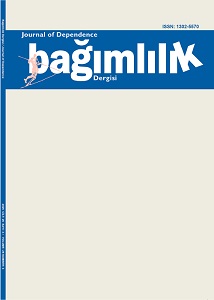SELF-İNJURİOUS BEHAVİOR BY CAROTİD SİNUS PRESSURE: CASE REPORT
Keywords:
Adolescent, addiction, self-injurious behaviourAbstract
Objective: It has been observed that self-injurious behavior usually starts between 13-19 years of age. Once started, this behavior gains addictive properties and it can be quite difficult for th one to stop it. Manual stimulation of the carotid sinus results in reduced blood pressure, decrease in heart rate and syncope or cardiac arrest may occur. A 15-year-old adolescent girl who has self-injurious behavior by choking will be placed in the present case.
Methods: The patient underwent the first psychiatric interview in outpatient clinic and evaluated by youth mental health unit team later. Projective tests, organi-city tests and Self Injurious Behaviour Assessment Inventory were applied to the patient. With the preliminary diagnosis of Adjustment Disorder with Depressed Mood, Attention Deficit and Hyperactivity Disorder and self-injurious behavior, a clinic follow-up arranged with medical treatment.
Results: Thematic Apperception Test resulted in anger against family members, aggression and hostile feelings and thoughts, separation individuation difficulties, the feeling of emptiness and loneliness are a result of family break. In the blank card she dreamed herself in the heaven alone and peaceful, as suggesting the risk of suicide.
Conclusions: Self-injurious behavior and substance use is observed together in high rates. In this regard close monitoring and security of the case would be appropriate.
References
Simeon D, Stein DJ, Hollander E. Depersonalization disorder and self injurious behavior. J Clin Psychiatry 1995; 55: 36-40.
Favazza AR. The coming of age of self-mutilation. J Nerv Ment Dis 1998; 186 (Suppl. 5): 259-68.
Aksoy A, Ögel K. Sokakta yaşayan çocuklarda kendine zarar verme davranışı ve madde kullanımı. Anadolu Psikiyatri Dergisi 2005; 6: 163-169.
Favazza AR, Conterio K. Female habitual self- mutilators. Acta Psychiatr Scand 1989; 79: 283-289.
Briere J, Gill E. Self mutilation in clinical and general population samples: prev- alence, correlates and functions. Am J Orthopsychiatry 1998; 68: 609-620.
Langbehn D, Pfohl B. Clinical correlates of self-mutilation among psychiatric inpatients. Ann Clin Psychiatry 1993; 5: 45-53.
Zoroğlu SS, Tüzün Ü, Şar V, et al. Suicide attempt and self-mutilation among Turkish high school students in relation with abuse, neglect and dissociation. Psychiatry Clin Neurosci 2003; 57: 119-126.
Başay BK, Başay Ö, Bildik T, ve ark. İzmir ili genelinde liseli gençlerde kendine zarar verme davranışı: Yaygınlığı, psikopatoloji ile ilişkisi ve intihar olasılığı. 16. Ergen Günleri Özet Kitapçığı, 2011: 40.
Toprak S, Çetin İ, Güven T, et al. Self-harm, suicidal ideation and suicide attempts among college students. Psychiatry Res 2011; 187: 140-144.
American Psychiatric Association Diagnostic and Statistical Manual of Mental Disorders. 4th Edition. Washington DC, 1994.
American Psychiatric Association Diagnostic and Statistical Manual of Mental Disorders. 5th Edition. American Psychiatric Publishing, 2013.
Aksoy A, Ögel K. Kendine zarar verme davranışı. Anadolu Psikiyatri Dergisi 2003; 4: 226-236.
Muehlenkamp JJ, Gutierrez PM. Risk for suicide attempts among adolescents who engage in non- suicide selfinjury. Arch Suicide Res 2007; 11: 69-82.
Pattison EM, Kahan J. The deliberate self-harm syndrome. Am J Psychiatry 1983; 14: 867-872.
Tarlacı N, Yeşilbursa D, Türkcan S, ve ark. B kümesi kişilik bozukluklarında kendini yaralamanın özellikleri. Türk Psikiyatri Dergisi 1997; 8: 29-35.
Peterson J, Freedenthal S, Sheldon C, et al. Nonsuicidal Self injury in Adolescents. Psychiatry (Edgmont) 2008; 5 (Suppl. 11): 20-26.
Özcan C. Bir ergende kompulsif tarzda senkop ataklarıyla oluşturulan kendine zarar verme davranışı. Çağdaş Tıp Dergisi 2011; 1 (Suppl. 2): 78-80.
Carroll JL, Kim I. Carotid chemoreceptor “resetting” revisited. Respir Physiol Neurobiol. 2013; 185 (Suppl. 1): 30-43.
Dake JA, Price JH, Kolm-Valdivia N, Wielin-ski M. Association of adolescent choking game activity with selected risk behaviors. Acad Pediatr. 2010; 10 (Suppl. 6): 410-416.
Ramowski SK, Nystrom RJ, Rosenberg KD, et al. Health risks of Oregon eighth-grade participants in the “chokinggame” Resultsfrom a populationbased survey. Pediatrics. 2012; 129: 846-851.
Macnab AJ, Deevska M, Gagnon F, et al. Asphyx-ial games or “the choking game”: a potentially fatal risk behaviour. Inj Prev. 2009; 15: 45–49.
Bildik T, Somer O, Basay BK ve ark. Kendine zarar verme davranışı değerlendirme envanteri’nin Türkçe formunun geçerlik ve güvenilirlik çalışması. Türk Psikiyatri Dergisi 2012; 23: 49-57.
Lüleci S. Kendini Yaralama Davranışı Olan Ergenlerin Psikiyatrik ve Sosyokültürel Özellikleri. Yayımlanmamış UzmanlıkTezi, İstanbul: Bakırköy Prof. Dr. Mazhar Osman Ruh Sağlığı ve Sinir Hastalıkları Eğitim ve Araştırma Hastanesi, 2007.
Dülger HE, Tokdemir M, Tezcan EA, ve ark. Elazığ Islahevi’ndeki çocuk ve ergen hükümlülerde kendini yaralama davranışı. Düşünen Adam 1997; 10: 18-21.
Aktepe E, Çalışkan S, Sönmez Y. Kendine zarar veren ergenlerin aile işlevlerinin ve benlik saygılarının saptanması: Olgu-Kontrol Çalışması. Anadolu Psikiyatri Dergisi 2014; 15 (Suppl. 1): 69-76.
Greydanus DE, Shek D. Deliberate Selfharm and Suicide in Adolescents. Keio J Med. 2009; 58 (Suppl. 3): 144-151.
Klonsky ED. The functions of deliberate selfinjury: A review of the evidence. Clinical Psychology Review 2007; 27(Suppl. 2):226-239.
Favazza AR, Rosenthal RJ. Diagnostic issues in self mutilation. Hosp Community Psychiatry 1993; 44: 134-140.
Olfson M, Gameroff MJ, Marcus SC, et al. National trends in hospitalization of youth with intentional-self-inflicted injuries. Am J Psychiatry 2005; 162: 1328-1335.
Hawton K, Saunders KE, O’Connor RC. Self-harm and suicide in adolescents. Lancet 2012; 379: 2373-2382.
Nixon MK, Heath NL. Self-injury in Youth. The Essential Guide to Assessment and Intervention, New York, Routledge, 2009.
Brausch AM, Gutierrez PM. Differences in non-suicidal self-injury and suicide attempts in adolescents. J Youth Adolesc 2010; 39: 233-242.
Kennedy BL, Feldmann TB. Self-inflicted eye injuries: case presentations and a literature review. Hosp Community Psychiatry 1994; 45: 470-474.
Centers for Disease Control and Prevention. Unintentional strangulation deaths from the “choking game” among youths aged 6–19 years, United States, 1995–2007. Morb Mortal Wkly Rep. 2008; 57: 141-144.
Andrew TA, Macnab A, Russell P. Update on the “choking game”. J Pediatr. 2009; 155: 777-780.
Downloads
Published
How to Cite
Issue
Section
License
Copyright (c) 2025 Journal of Dependence

This work is licensed under a Creative Commons Attribution-NonCommercial-NoDerivatives 4.0 International License.
...
